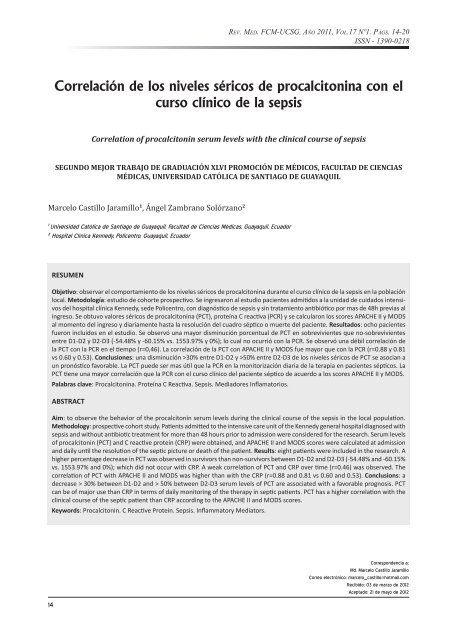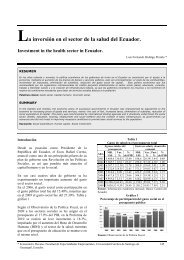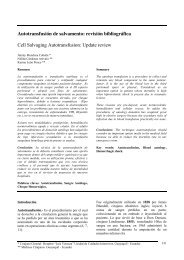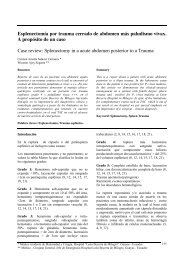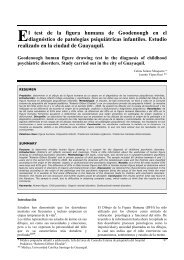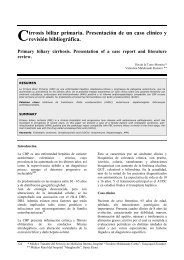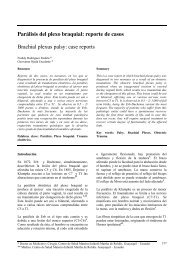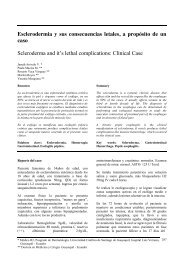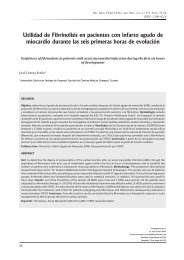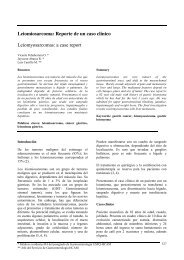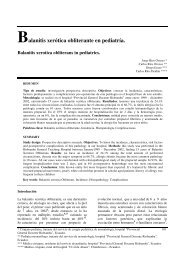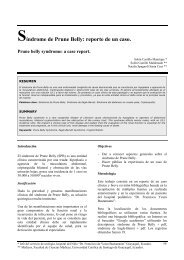Correlación de los niveles séricos de procalcitonina con el curso ...
Correlación de los niveles séricos de procalcitonina con el curso ...
Correlación de los niveles séricos de procalcitonina con el curso ...
You also want an ePaper? Increase the reach of your titles
YUMPU automatically turns print PDFs into web optimized ePapers that Google loves.
Rev. Med. FCM-UCSG, Año 2011, Vol.17 Nº1. Págs. 14-20<br />
ISSN - 1390-0218<br />
Corr<strong>el</strong>ación <strong>de</strong> <strong>los</strong> <strong>niv<strong>el</strong>es</strong> séricos <strong>de</strong> <strong>procalcitonina</strong> <strong>con</strong> <strong>el</strong><br />
<strong>curso</strong> clínico <strong>de</strong> la sepsis<br />
Corr<strong>el</strong>ation of procalcitonin serum lev<strong>el</strong>s with the clinical course of sepsis<br />
SEGUNDO MEJOR TRABAJO DE GRADUACIÓN XLVI PROMOCIÓN DE MÉDICOS, FACULTAD DE CIENCIAS<br />
MÉDICAS, UNIVERSIDAD CATÓLICA DE SANTIAGO DE GUAYAQUIL<br />
Marc<strong>el</strong>o Castillo Jaramillo 1 , Áng<strong>el</strong> Zambrano Solórzano 2<br />
1<br />
Universidad Católica <strong>de</strong> Santiago <strong>de</strong> Guayaquil, Facultad <strong>de</strong> Ciencias Médicas, Guayaquil, Ecuador<br />
2<br />
Hospital Clínica Kennedy, Policentro. Guayaquil, Ecuador<br />
RESUMEN<br />
Objetivo: observar <strong>el</strong> comportamiento <strong>de</strong> <strong>los</strong> <strong>niv<strong>el</strong>es</strong> séricos <strong>de</strong> <strong>procalcitonina</strong> durante <strong>el</strong> <strong>curso</strong> clínico <strong>de</strong> la sepsis en la población<br />
local. Metodología: estudio <strong>de</strong> cohorte prospectivo. Se ingresaron al estudio pacientes admitidos a la unidad <strong>de</strong> cuidados intensivos<br />
<strong>de</strong>l hospital clínica Kennedy, se<strong>de</strong> Policentro, <strong>con</strong> diagnóstico <strong>de</strong> sepsis y sin tratamiento antibiótico por mas <strong>de</strong> 48h previas al<br />
ingreso. Se obtuvo valores séricos <strong>de</strong> <strong>procalcitonina</strong> (PCT), proteína C reactiva (PCR) y se calcularon <strong>los</strong> scores APACHE II y MODS<br />
al momento <strong>de</strong>l ingreso y diariamente hasta la resolución <strong>de</strong>l cuadro séptico o muerte <strong>de</strong>l paciente. Resultados: ocho pacientes<br />
fueron incluidos en <strong>el</strong> estudio. Se observó una mayor disminución porcentual <strong>de</strong> PCT en sobrevivientes que no-sobrevivientes<br />
entre D1-D2 y D2-D3 (-54.48% y -60.15% vs. 1553.97% y 0%); lo cual no ocurrió <strong>con</strong> la PCR. Se observó una débil corr<strong>el</strong>ación <strong>de</strong><br />
la PCT <strong>con</strong> la PCR en <strong>el</strong> tiempo (r=0,46). La corr<strong>el</strong>ación <strong>de</strong> la PCT <strong>con</strong> APACHE II y MODS fue mayor que <strong>con</strong> la PCR (r=0.88 y 0.81<br />
vs 0.60 y 0.53). Conclusiones: una disminución >30% entre D1-D2 y >50% entre D2-D3 <strong>de</strong> <strong>los</strong> <strong>niv<strong>el</strong>es</strong> séricos <strong>de</strong> PCT se asocian a<br />
un pronóstico favorable. La PCT pue<strong>de</strong> ser mas útil que la PCR en la monitorización diaria <strong>de</strong> la terapia en pacientes sépticos. La<br />
PCT tiene una mayor corr<strong>el</strong>ación que la PCR <strong>con</strong> <strong>el</strong> <strong>curso</strong> clínico <strong>de</strong>l paciente séptico <strong>de</strong> acuerdo a <strong>los</strong> scores APACHE II y MODS.<br />
Palabras clave: Procalcitonina. Proteína C Reactiva. Sepsis. Mediadores Inflamatorios.<br />
ABSTRACT<br />
Aim: to observe the behavior of the procalcitonin serum lev<strong>el</strong>s during the clinical course of the sepsis in the local population.<br />
Methodology: prospective cohort study. Patients admitted to the intensive care unit of the Kennedy general hospital diagnosed with<br />
sepsis and without antibiotic treatment for more than 48 hours prior to admission were <strong>con</strong>si<strong>de</strong>red for the research. Serum lev<strong>el</strong>s<br />
of procalcitonin (PCT) and C reactive protein (CRP) were obtained, and APACHE II and MODS scores were calculated at admission<br />
and daily until the resolution of the septic picture or <strong>de</strong>ath of the patient. Results: eight patients were inclu<strong>de</strong>d in the research. A<br />
higher percentage <strong>de</strong>crease in PCT was observed in survivors than non-survivors between D1-D2 and D2-D3 (-54.48% and -60.15%<br />
vs. 1553.97% and 0%); which did not occur with CRP. A weak corr<strong>el</strong>ation of PCT and CRP over time (r=0.46) was observed. The<br />
corr<strong>el</strong>ation of PCT with APACHE II and MODS was higher than with the CRP (r=0.88 and 0.81 vs 0.60 and 0.53). Conclusions: a<br />
<strong>de</strong>crease > 30% between D1-D2 and > 50% between D2-D3 serum lev<strong>el</strong>s of PCT are associated with a favorable prognosis. PCT<br />
can be of major use than CRP in terms of daily monitoring of the therapy in septic patients. PCT has a higher corr<strong>el</strong>ation with the<br />
clinical course of the septic patient than CRP according to the APACHE II and MODS scores.<br />
Keywords: Procalcitonin. C Reactive Protein. Sepsis. Inflammatory Mediators.<br />
14<br />
Correspon<strong>de</strong>ncia a:<br />
Md. Marc<strong>el</strong>o Castillo Jaramillo<br />
Correo <strong>el</strong>ectrónico: marc<strong>el</strong>o_castillo@hotmail.com<br />
Recibido: 03 <strong>de</strong> marzo <strong>de</strong> 2012<br />
Aceptado: 21 <strong>de</strong> mayo <strong>de</strong> 2012
PROCALCITONINA y CURSO CLÍNICO DE LA SEPSIS<br />
Introducción<br />
La <strong>procalcitonina</strong> (PCT) es <strong>el</strong> propéptido <strong>de</strong><br />
la calcitonina, un glicopéptido que carece <strong>de</strong><br />
actividad hormonal. Es producido por las células<br />
C <strong>de</strong> la glándula tiroi<strong>de</strong>a, asi como por tejidos<br />
extratiroi<strong>de</strong>os.<br />
Sus <strong>niv<strong>el</strong>es</strong> séricos en personas sanas son casi<br />
in<strong>de</strong>tectables (
M. CASTILLO, A. ZAMBRANO<br />
Se recolectaron datos <strong>de</strong> <strong>los</strong> pacientes hasta la<br />
resolución <strong>de</strong>l cuadro séptico o la muerte.<br />
Los criterios <strong>de</strong> inclusión se <strong>de</strong>finieron <strong>de</strong> acuerdo<br />
a <strong>los</strong> emitidos por <strong>el</strong> American College of Chest<br />
Physicians/Society of Critical Care Medicine<br />
(ACCP/SCCM) para <strong>el</strong> diagnóstico <strong>de</strong> sepsis, la<br />
misma que se <strong>de</strong>finió como: SRIS + foco infeccioso<br />
re<strong>con</strong>ocible; <strong>de</strong>finiendo SRIS como dos o más<br />
criterios <strong>de</strong> <strong>los</strong> siguientes:<br />
– Temperatura corporal >38 °C o 90 latidos por minuto<br />
– Taquipnea >20 respiraciones por minuto o<br />
PaCO2 12.000 células/mcl,
PROCALCITONINA y CURSO CLÍNICO DE LA SEPSIS<br />
Corr<strong>el</strong>ación PCT vs PCR<br />
El coeficiente <strong>de</strong> corr<strong>el</strong>ación <strong>de</strong> la PCT vs PCR<br />
durante todo <strong>el</strong> <strong>curso</strong> clínico <strong>de</strong> <strong>los</strong> pacientes<br />
fue <strong>de</strong> r=0.46; <strong>los</strong> valores en <strong>el</strong> grupo <strong>de</strong> <strong>los</strong><br />
sobrevivientes y no sobrevivientes fueron r=0.29 y<br />
0.79 respectivamente. El coeficiente <strong>de</strong> corr<strong>el</strong>ación<br />
<strong>de</strong> las variaciones <strong>de</strong> la PCT vs PCR <strong>de</strong>terminado<br />
por <strong>los</strong> valores ΔPCT y ΔPCR fueron r=0, <strong>los</strong> valores<br />
en <strong>el</strong> grupo <strong>de</strong> sobrevivientes y no sobrevivientes<br />
fueron r=-0.16 y 0.78 respectivamente.<br />
Corr<strong>el</strong>ación PCT y PCR vs APACHE II y MODS<br />
El coeficiente <strong>de</strong> corr<strong>el</strong>ación <strong>de</strong> la PCT vs APACHE<br />
II fue <strong>de</strong> r=0.88; <strong>los</strong> valores en <strong>el</strong> grupo <strong>de</strong><br />
sobrevivientes y no sobrevivientes fueron <strong>de</strong><br />
r=0.89 y 0.86 respectivamente. El coeficiente <strong>de</strong><br />
corr<strong>el</strong>ación <strong>con</strong> <strong>el</strong> MODS fue <strong>de</strong> r=0.81; <strong>los</strong> valores<br />
en <strong>el</strong> grupo <strong>de</strong> sobrevivientes y no sobrevivientes<br />
fue <strong>de</strong> 0.80 y 0.86 respectivamente. El coeficiente<br />
<strong>de</strong> corr<strong>el</strong>ación <strong>de</strong> la PCR vs APACHE II fue <strong>de</strong><br />
r=0.60; <strong>los</strong> valores en <strong>el</strong> grupo <strong>de</strong> sobrevivientes<br />
y no sobrevivientes fueron <strong>de</strong> r=0.497 y 0.86. El<br />
coeficiente <strong>de</strong> corr<strong>el</strong>ación <strong>con</strong> <strong>el</strong> MODS fue <strong>de</strong><br />
r=0.53; <strong>los</strong> valores en <strong>el</strong> grupo <strong>de</strong> sobrevivientes<br />
y no sobrevivientes fue <strong>de</strong> 0.35 y 0.96.<br />
Figura 1. PCT, PCR, APACHE II y MODS durante <strong>el</strong> <strong>curso</strong><br />
clínico <strong>de</strong> la sepsis - sobrevivientes<br />
Discusión<br />
El propósito <strong>de</strong> este estudio fue observar <strong>el</strong><br />
comportamiento <strong>de</strong> <strong>los</strong> <strong>niv<strong>el</strong>es</strong> séricos <strong>de</strong><br />
<strong>procalcitonina</strong> durante <strong>el</strong> <strong>curso</strong> clínico <strong>de</strong> un<br />
paciente séptico en la población local.<br />
Los resultados indican que una disminución >30%<br />
entre <strong>el</strong> primer y segundo día <strong>de</strong>l comienzo <strong>de</strong>l<br />
cuadro séptico y una disminución >50% entre <strong>el</strong><br />
segundo y tercer día están asociados a un pronóstico<br />
favorable, lo cual podría estar asociado a una<br />
terapéutica efectiva. De hecho, en aqu<strong>el</strong><strong>los</strong> pacientes<br />
<strong>con</strong> un <strong>curso</strong> clínico favorable, se observó una<br />
disminución progresiva <strong>de</strong>l 30% al 60% <strong>de</strong> <strong>los</strong> <strong>niv<strong>el</strong>es</strong><br />
<strong>de</strong> PCT hasta llegar a un niv<strong>el</strong> basal
M. CASTILLO, A. ZAMBRANO<br />
Estas observaciones no se obtuvieron <strong>con</strong> <strong>los</strong><br />
<strong>niv<strong>el</strong>es</strong> séricos <strong>de</strong> PCR, es <strong>de</strong>cir no se en<strong>con</strong>traron<br />
variaciones significativas durante <strong>los</strong> tres primeros<br />
días <strong>de</strong> sepsis en ambos grupos, a pesar <strong>de</strong> que sí<br />
se observó una ten<strong>de</strong>ncia positiva <strong>de</strong> <strong>los</strong> <strong>niv<strong>el</strong>es</strong><br />
séricos <strong>de</strong> PCR en <strong>el</strong> grupo <strong>de</strong> <strong>los</strong> no sobrevivientes.<br />
La corr<strong>el</strong>ación entre la PCT y la PCR durante<br />
todo <strong>el</strong> <strong>curso</strong> clínico <strong>de</strong> <strong>los</strong> pacientes fue positiva<br />
pero débil, siendo inclusive nula en <strong>el</strong> caso <strong>de</strong> las<br />
variaciones diarias <strong>de</strong> ambos grupos, negativa en <strong>el</strong><br />
grupo <strong>de</strong> <strong>los</strong> sobrevivientes, y fuertemente positiva<br />
en <strong>el</strong> grupo <strong>de</strong> <strong>los</strong> no sobrevivientes (tabla 2).<br />
Estas observaciones podrían indicar que la monitorización<br />
<strong>de</strong> <strong>los</strong> <strong>niv<strong>el</strong>es</strong> séricos <strong>de</strong> PCT es más útil<br />
que la PCR para la valoración <strong>de</strong> la terapéutica en<br />
pacientes sépticos; por tanto la medicación antibiótica<br />
será eficaz en <strong>los</strong> casos en don<strong>de</strong> se observe<br />
una disminución progresiva <strong>de</strong> la PCT, mientras<br />
que la terapéutica será ineficaz en <strong>los</strong> casos don<strong>de</strong><br />
se observe una falta <strong>de</strong> disminución o un incremento<br />
<strong>de</strong> la PCT.<br />
También se observó una mayor corr<strong>el</strong>ación <strong>de</strong> la<br />
PCT <strong>con</strong> <strong>los</strong> scores <strong>de</strong> gravedad APACHE II y fallo<br />
multiorgánico MODS que <strong>con</strong> la PCR; <strong>de</strong> hecho, se<br />
en<strong>con</strong>tró que la PCR tenía una corr<strong>el</strong>ación fuerte<br />
solo en <strong>el</strong> grupo <strong>de</strong> <strong>los</strong> no sobrevivientes.<br />
Los estudios <strong>de</strong> la PCT divulgados <strong>de</strong>s<strong>de</strong> <strong>el</strong> año<br />
1991, año <strong>de</strong> la primera publicación <strong>de</strong> este<br />
glicopéptido en artícu<strong>los</strong> médicos, se centran<br />
principalmente en la <strong>de</strong>terminación <strong>de</strong> puntos <strong>de</strong><br />
corte para valores séricos absolutos <strong>de</strong> PCT que<br />
ayu<strong>de</strong>n a diferenciar un SRIS <strong>de</strong> una sepsis en<br />
cualquiera <strong>de</strong> sus varieda<strong>de</strong>s. 2-11<br />
Sin embargo, <strong>los</strong> últimos diez años se han<br />
observado hallazgos que sugieren la posible<br />
utilidad <strong>de</strong> la monitorización <strong>de</strong> la dinámica <strong>de</strong> la<br />
PCT en lugar <strong>de</strong> utilizar valores absolutos <strong>de</strong> la<br />
misma. 5,9 Dicha utilidad podría <strong>de</strong>berse a su fuerte<br />
corr<strong>el</strong>ación <strong>con</strong> la gravedad <strong>de</strong>l paciente, <strong>con</strong> <strong>el</strong><br />
tiempo <strong>de</strong> estancia hospitalaria y <strong>con</strong> la mortalidad<br />
<strong>de</strong> pacientes sépticos.<br />
También se ha observado que las <strong>de</strong>terminaciones<br />
<strong>de</strong> PCT son más útiles en comparación <strong>con</strong> la PCR<br />
<strong>de</strong>bido a que ésta posee una corr<strong>el</strong>ación mas<br />
fuerte <strong>con</strong> la gravedad <strong>de</strong> la sepsis a<strong>de</strong>más <strong>de</strong> la<br />
habilidad <strong>de</strong> la PCT <strong>de</strong> reaccionar más rápido a<br />
<strong>los</strong> cambios <strong>de</strong>l estado clínico séptico, 2-5,8,10,20,24<br />
habilidad que no se compromete en casos<br />
específicos como insuficiencia renal crónica,<br />
diálisis, inmuno<strong>de</strong>ficiencias o enfermeda<strong>de</strong>s<br />
autoinmunes, en don<strong>de</strong> si se altera la PCR. 21-23<br />
La dinámica <strong>de</strong>scrita en <strong>el</strong> grupo <strong>de</strong> no<br />
sobrevivientes, en la que una <strong>el</strong>evación <strong>de</strong> <strong>los</strong><br />
<strong>niv<strong>el</strong>es</strong> <strong>de</strong> la PCT durante <strong>los</strong> primeros tres días<br />
<strong>de</strong> la sepsis ya ha sido <strong>de</strong>scrita como predictor<br />
in<strong>de</strong>pendiente <strong>de</strong> mortalidad en estudios<br />
publicados en <strong>los</strong> últimos años, 13,14,16-18 siendo<br />
también en <strong>el</strong> grupo <strong>de</strong> <strong>los</strong> sobrevivientes en <strong>el</strong><br />
que una dinámica <strong>con</strong> ten<strong>de</strong>ncia a la disminución<br />
progresiva <strong>de</strong> la PCT ha sido asociada a un buen<br />
pronóstico, y una dinámica <strong>con</strong> ten<strong>de</strong>ncia a<br />
<strong>niv<strong>el</strong>es</strong> mayores <strong>de</strong> PCT se asociaron a un mal<br />
pronóstico. De hecho, en un estudio 14 se propuso<br />
que la disminución >30% <strong>de</strong> <strong>los</strong> <strong>niv<strong>el</strong>es</strong> séricos<br />
<strong>de</strong> PCT entre <strong>el</strong> segundo y tercer día <strong>de</strong> sepsis es<br />
un predictor <strong>de</strong> terapia antimicrobiana empírica<br />
efectiva.<br />
Tabla 2. Corr<strong>el</strong>aciones entre PCT, PCR, APACHE y MODS<br />
Global Vivos Muertos<br />
PCT - PCR 0.46 0.29 0.79<br />
ΔPCT - ΔPCR 0.00 -0.16 0.78<br />
PCT - APACHE II 0.88 0.89 0.86<br />
PCT - MODS 0.81 0.80 0.86<br />
PCR - APACHE II 0.60 0.50 0.86<br />
PCR - MODS 0.53 0.35 0.96<br />
18 Rev. Med. FCM-UCSG, Año 2011, Vol.17 Nº1
PROCALCITONINA y CURSO CLÍNICO DE LA SEPSIS<br />
Dichos hallazgos <strong>de</strong> corr<strong>el</strong>ación <strong>con</strong> la gravedad<br />
clínica <strong>de</strong>l paciente y las ten<strong>de</strong>ncias dinámicas <strong>de</strong><br />
la PCT a disminuir en <strong>el</strong> grupo <strong>de</strong> <strong>los</strong> sobrevivientes<br />
y a aumentar en <strong>el</strong> grupo <strong>de</strong> <strong>los</strong> no sobrevivientes<br />
también se observaron en este estudio; sin<br />
embargo, es <strong>de</strong> gran importancia <strong>de</strong>stacar que <strong>el</strong><br />
tamaño <strong>de</strong> la población incluida es pequeña, por lo<br />
que dichos hallazgos no pue<strong>de</strong>n ser generalizados<br />
al resto <strong>de</strong> la población local.<br />
En la actualidad, existen pocos estudios <strong>con</strong><br />
parámetros similares a este trabajo que analizan<br />
<strong>el</strong> comportamiento <strong>de</strong> PCT en <strong>el</strong> <strong>curso</strong> <strong>de</strong> la<br />
sepsis 14,17,18 por lo que <strong>los</strong> hallazgos en<strong>con</strong>trados<br />
son una importante evi<strong>de</strong>ncia, que apoyada en la<br />
literatura ya existente, aportan al <strong>con</strong>ocimiento <strong>de</strong>l<br />
comportamiento <strong>de</strong> la <strong>procalcitonina</strong> durante <strong>el</strong><br />
<strong>curso</strong> <strong>de</strong> un paciente séptico en la población local.<br />
En lo referente al tamaño <strong>de</strong> la población, ésta<br />
pue<strong>de</strong> explicarse en gran parte por la corta<br />
duración <strong>de</strong>l estudio, aunque también <strong>con</strong>tribuyó<br />
la falta <strong>de</strong> cooperación <strong>de</strong> algunos médicos<br />
tratantes, reflejando <strong>el</strong> poco uso <strong>de</strong> la PCT a niv<strong>el</strong><br />
local, y la utilización <strong>de</strong> agentes antimicrobianos<br />
previo ingreso a la UCI, reflejando talvez <strong>el</strong> uso<br />
indiscriminado <strong>de</strong> antibióticos que ocurre en este<br />
medio.<br />
La patología séptica es una <strong>de</strong> las más comunes en<br />
las unida<strong>de</strong>s <strong>de</strong> cuidados intensivos en <strong>el</strong> país, y una<br />
<strong>de</strong> las patologías que <strong>con</strong>llevan una mayor tasa <strong>de</strong><br />
mortalidad, mayor tiempo <strong>de</strong> estancia hospitalaria,<br />
mayor costo <strong>de</strong> tratamiento y costos por pérdida<br />
<strong>de</strong> productividad <strong>de</strong>l paciente, llegando a alcanzar<br />
hasta 17 billones <strong>de</strong> dólares anuales solo en <strong>los</strong><br />
Estados Unidos 25 , por lo que la i<strong>de</strong>a <strong>de</strong> que la PCT<br />
pueda ser utilizada como herramienta clínica que<br />
ayu<strong>de</strong> a <strong>de</strong>terminar si la terapéutica instaurada es<br />
efectiva o no, es alentadora, ya que nos proveería<br />
<strong>de</strong> una herramienta clínica invaluable en la lucha<br />
<strong>de</strong> esta catastrófica patología, ayudándonos a una<br />
optimización <strong>de</strong> re<strong>curso</strong>s y a disminuir la mortalidad<br />
al brindarnos una <strong>de</strong>seada certeza terapéutica.<br />
Agra<strong>de</strong>cimiento<br />
Se expresa <strong>los</strong> más profundos agra<strong>de</strong>cimientos a: hospital<br />
clínica Kennedy, laboratorios Arriaga; Doctores: Gabri<strong>el</strong>a<br />
Vergara Saltos, Cristina Arboleda Cabrera, Jéssica<br />
Cando Loor, Carolina García y Dani<strong>el</strong> Tettamanti Miranda.<br />
Referencias bibliográficas<br />
1. Karzai W, Oberhoffer M, Meier-H<strong>el</strong>lmann A, Reinhart K.<br />
Procalcitonin--a new indicator of the systemic response to<br />
severe infections. Infection. 1997 Nov-Dec;25(6):329-34.<br />
2. Endo S, Aikawa N, Fujishima S, Sekine I, Kogawa K, Yamamoto<br />
Y, Kushimoto S, Yukioka H, Kato N, Totsuka K, Kikuchi K, Ikeda<br />
T, Ikeda K, Yamada H, Harada K, Satomura S. Usefulness of<br />
procalcitonin serum lev<strong>el</strong> for the discrimination of severe sepsis<br />
from sepsis: a multicenter prospective study. J Infect Chemother.<br />
2008 Jun;14(3):244-9.<br />
3. Cast<strong>el</strong>li GP, Pognani C, Meisner M, Stuani A, B<strong>el</strong>lomi D, Sgarbi<br />
L. Procalcitonin and C-reactive protein during systemic<br />
inflammatory response syndrome, sepsis and organ dysfunction.<br />
Crit Care. 2004 Aug;8(4):R234-42.<br />
4. Yukioka H, Yoshida G, Kurita S, Kato N. Plasma procalcitonin<br />
in sepsis and organ failure. Ann Acad Med Singapore. 2001<br />
Sep;30(5):528-31.<br />
5. Sponholz C, Sakr Y, Reinhart K, Brunkhorst F. Diagnostic value<br />
and prognostic implications of serum procalcitonin after<br />
cardiac surgery: a systematic review of the literature. Crit Care.<br />
2006;10(5):R145.<br />
6. Czerwionka-Szaflarska M, Parzecka M. [Role of procalcitonin<br />
<strong>con</strong>centration in clinical diagnosis]. Pol Merkur Lekarski. 2005<br />
Oct;19(112):584-6.<br />
7. Sitter T, Schmidt M, Schnei<strong>de</strong>r S, Schiffl H. Differential<br />
diagnosis of bacterial infection and inflammatory response<br />
in kidney diseases using procalcitonin. J Nephrol. 2002 May-<br />
Jun;15(3):297-301.<br />
8. Hatzistilianou M. Diagnostic and prognostic role of procalcitonin<br />
in infections. ScientificWorldJournal. 2010 Oct 1;10:1941-6.<br />
9. Picari<strong>el</strong>lo C, Lazzeri C, Valente S, Chiostri M, Attanà P, Gensini<br />
GF. Kinetics of procalcitonin in cardiogenic shock and in septic<br />
shock. Pr<strong>el</strong>iminary data. Acute Card Care. 2010 Sep;12(3):96-<br />
101.<br />
10. Liu XL, Du B, Pan JQ, Xu Y, Hua BL. [Role of procalcitonin in<br />
the differentiation and surveillance of systemic inflammatory<br />
response syndrome]. Zhongguo Yi Xue Ke Xue Yuan Xue Bao.<br />
2005 Feb;27(1):48-52.<br />
11. Holub M, Rozsypal H, Chalupa P. [Procalcitonin: a r<strong>el</strong>iable marker<br />
for the diagnosis and monitoring of the course of bacterial<br />
infection]. Klin Mikrobiol Infekc Lek. 2008 Dec;14(6):201-8.<br />
12. Rau B, Krüger CM, Schilling MK. Procalcitonin: improved<br />
biochemical severity stratification and postoperative monitoring<br />
in severe abdominal inflammation and sepsis. Langenbecks Arch<br />
Surg. 2004 Apr; 389(2):134-44.<br />
13. Hillas G, Vassilakopou<strong>los</strong> T, Plantza P, Rasidakis A, Bakakos P.<br />
C-reactive protein and procalcitonin as predictors of survival<br />
and septic shock in ventilator-associated pneumonia. Eur Respir<br />
J. 2010 Apr;35(4):805-11.<br />
Rev. Med. FCM-UCSG, Año 2011, Vol.17 Nº1<br />
19
M. CASTILLO, A. ZAMBRANO<br />
14. Charles PE, Tin<strong>el</strong> C, Barbar S, Aho S, Prin S, Doise JM, Olsson NO,<br />
Blettery B, Quenot JP. Procalcitonin kinetics within the first days<br />
of sepsis: r<strong>el</strong>ationship with the appropriateness of antibiotic<br />
therapy and the outcome. Crit Care. 2009;13(2):R38.<br />
15. Prieto B, Llorente E, González-Pinto I, Álvarez FV. Plasma<br />
procalcitonin measured by time-resolved amplified cryptate<br />
emission (TRACE) in liver transplant patients. A prognosis<br />
marker of early infectious and non-infectious postoperative<br />
complications. Clin Chem Lab Med. 2008;46(5):660-6.<br />
16. Jensen JU, Heslet L, Jensen TH, Espersen K, Steffensen P, Tve<strong>de</strong><br />
M. Procalcitonin increase in early i<strong>de</strong>ntification of critically<br />
ill patients at high risk of mortality. Crit Care Med. 2006 Oct;<br />
34(10):2596-602.<br />
17. Boussekey N, Leroy O, Alfandari S, Devos P, Georges H, Guery B.<br />
Procalcitonin kinetics in the prognosis of severe communityacquired<br />
pneumonia. Intensive Care Med. 2006 Mar; 32(3):469-<br />
72.<br />
18. Luyt CE, Guérin V, Combes A, Trouillet JL, Ayed SB, Bernard M,<br />
Gibert C, Chastre J. Procalcitonin kinetics as a prognostic marker<br />
of ventilator-associated pneumonia. Am J Respir Crit Care Med.<br />
2005 Jan 1;171(1): 48-53.<br />
19. Wolff M, Bouadma L. What procalcitonin brings to management<br />
of sepsis in the ICU. Crit Care. 2010;14(6):1007.<br />
20. Mitaka C. Clinical laboratory differentiation of infectious versus<br />
non-infectious systemic inflammatory response syndrome. Clin<br />
Chim Acta. 2005 Jan; 351(1-2):17-29.<br />
21. Meisner M, Lohs T, Huettemann E, Schmidt J, Hu<strong>el</strong>ler M,<br />
Reinhart K. The plasma <strong>el</strong>imination rate and urinary secretion<br />
of procalcitonin in patients with normal and impaired renal<br />
function. Eur J Anaesthesiol. 2001 Feb; 18(2):79-87.<br />
22. Meisner M, Hüttemann E, Lohs T, Kasakov L, Reinhart K.<br />
Elimination of procalcitonin and plasma <strong>con</strong>centrations during<br />
<strong>con</strong>tinuous veno-venous haemodiafiltration in septic patients.<br />
Eur J Anaesthesiol. 2000 Nov;17(11):665-71.<br />
23. De Kruif MD, Lemaire LC, Gieb<strong>el</strong>en IA, Struck J, Morgenthaler<br />
NG, Papassotiriou J, Elliott PJ, van <strong>de</strong>r Poll T. The influence of<br />
corticosteroids on the r<strong>el</strong>ease of nov<strong>el</strong> biomarkers in human<br />
endotoxemia. Intensive Care Med. 2008 Mar;34(3):518-22.<br />
24. Meisner M, Tschaikowsky K, Palmaers T, Schmidt J. Comparison<br />
of procalcitonin (PCT) and C-reactive protein (CRP) plasma<br />
<strong>con</strong>centrations at different SOFA scores during the course of<br />
sepsis and MODS. Crit Care. 1999;3(1):45-50.<br />
25. Silva E, Araujo D. V. E<strong>con</strong>omic and Social Bur<strong>de</strong>n of Severe<br />
Sepsis. En: Vincent Jean-Louis, editor. Yearbook of intensive<br />
care medicine. Springer Berlin Hei<strong>de</strong>lberg; 2009. p. 129-138.<br />
20 Rev. Med. FCM-UCSG, Año 2011, Vol.17 Nº1


